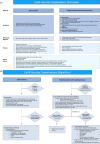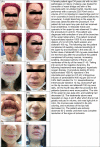Managing intravascular complications following treatment with calcium hydroxylapatite: An expert consensus
- PMID: 32185876
- PMCID: PMC7687073
- DOI: 10.1111/jocd.13353
Managing intravascular complications following treatment with calcium hydroxylapatite: An expert consensus
Abstract
Background: Inadvertent intra-arterial injection of dermal fillers including calcium hydroxylapatite (CaHA) can result in serious adverse events including soft tissue necrosis, permanent scarring, visual impairment, and blindness. When intra-arterial injection occurs, immediate action is required for optimal outcomes, but the infrequency of this event means that many physicians may never have experienced this scenario. The aim of this document is to provide evidence-based and expert opinion recommendations for the recognition and management of vascular compromise following inadvertent injection of CaHA.
Methods: An international group of experts with experience in injection of CaHA and management of vascular complications was convened to develop a consensus on the optimal management of vascular compromise following intra-arterial CaHA injection. The consensus members were asked to provide preventative advice for the avoidance of intravascular injection and to produce a treatment protocol for acute and delayed presentation. To ensure all relevant treatment options were included, the recommendations were supplemented with a PubMed search of the literature.
Results: For prevention of intra-arterial CaHA injection, consensus members outlined the importance of a thorough knowledge of facial vascular anatomy and patient history, as well as highlighting potential risk zones and optimal injection techniques. Individual sections document how to recognize the symptoms of vascular occlusion leading to vision loss and tissue necrosis as well as detailed treatment protocols for the management of these events. For impending tissue necrosis, recommendations are provided for early and delayed presentations with treatment protocols for acute and follow-up treatment. A separate section details the treatment options for open and closed wounds.
Conclusions: All physicians should be prepared for the eventuality of intra-arterial injection of a dermal filler, despite its rarity. These consensus recommendations combine advice from aesthetic experts with the latest reports from the published literature to provide an up-to-date office-based protocol for the prevention and treatment of complications arising from intra-arterial CaHA injection.
Keywords: calcium hydroxylapatite; dermal filler; intra-arterial injection; safety; vascular compromise; vision loss.
© 2020 The Authors. Journal of Cosmetic Dermatology published by Wiley Periodicals, Inc.
Figures





Comment in
-
A Multimodal Approach to Intra-arterial Occlusion With Calcium Hydroxylapatite.Dermatol Surg. 2023 Feb 1;49(2):218-220. doi: 10.1097/DSS.0000000000003667. Epub 2022 Dec 6. Dermatol Surg. 2023. PMID: 36728077 No abstract available.
References
-
- American Society for Aesthetic Plastic Surgery (ASAPS) . Cosmetic surgery national data bank statistics 2017. http://www.surgery.org/sites/default/files/2014‐Stats.pdf. Accessed November 18, 2018. - PubMed
-
- International Society of Aesthetic Plastic Surgery (ISAPS) . ISAPS international survey on aesthetic/cosmetic procedures performed in 2017. https://www.isaps.org/wp‐content/uploads/2019/03/ISAPS_2017_Internationa.... Accessed May 19, 2019.
-
- Hanke CW, Redbord KP. Safety and efficacy of poly‐L‐lactic acid in HIV lipoatrophy and lipoatrophy of aging. J Drugs Dermatol. 2007;6(2):123‐128. - PubMed
-
- Kadouch JA. Calcium hydroxylapatite: a review on safety and complications. J Cosmet Dermatol. 2017;16(2):152‐161. - PubMed
MeSH terms
Substances
LinkOut - more resources
Full Text Sources
Other Literature Sources
Medical

